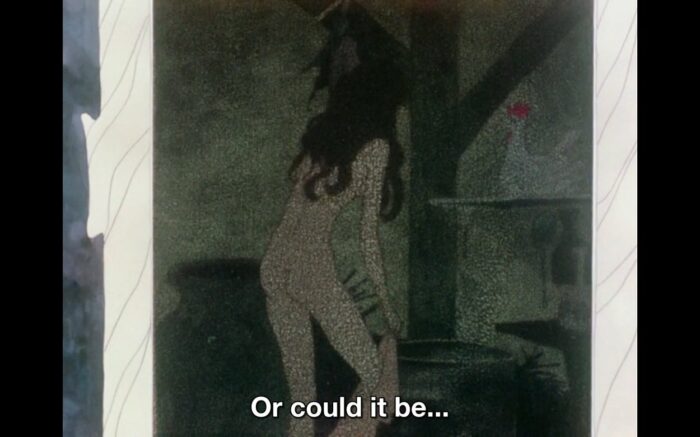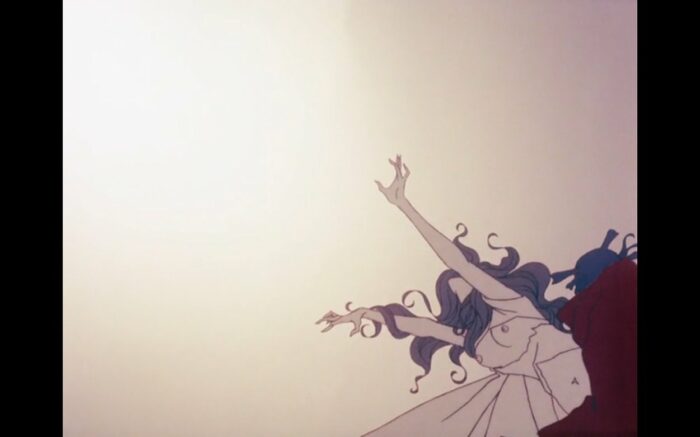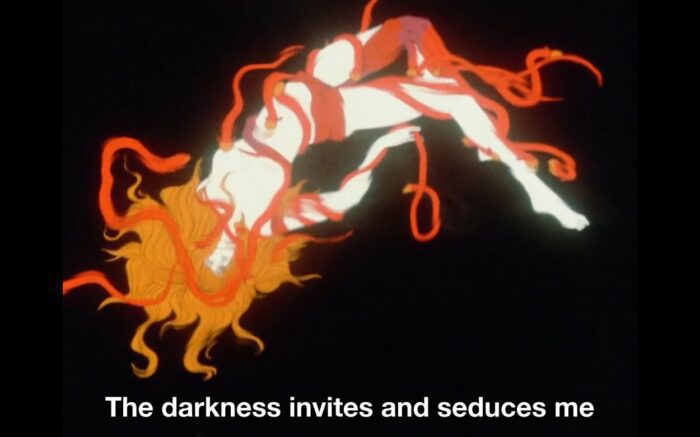Belladonna of Sadness (1973) could be likened to an FMRI of the human collective unconscious becoming conscious, also as seen through the Gnostic perspective. Here is the first repentance of Sophia from the Pistis Sophia. Upon closer inspection, it’s also a kind of summary of the film.
The first repentance of Sophia.
O Light of lights, in whom I have had faith from the beginning, hearken now then, O Light, unto my repentance. Save me, O Light, for evil thoughts have entered into me.
I gazed, O Light, into the lower parts and saw there a light. thinking: I will go to that region, in order that I may take that light. And I went and found myself in the darkness which is in the chaos below, and I could no more speed thence and go to my region, for I was sore pressed by all the emanations of Self-willed, and the lion-faced power took away my light in me.
And I cried for help, but my voice hath not reached out of the darkness. And I looked unto the height, that the Light, in which I had had faith, might help me.

Whore-in-church trope
In faith wisdom, in the Pistis Sophia, you will purify from the inside out.
Disclaimer: I know not everyone grew up or chooses to be religious. I don’t blame you. But I also know that symbols carry, characters speak, and metaphors are just as real as you and me.
There are those of you here, right now, who yearn for something outside the chasm of skeptical delight of overcoming your intellectual inferiors, who haven’t fully resigned yourselves to settling for “nothing matters”. Nothing does matter. And everything does matter. And matter, like God, exists because people believe in it. It’s absurd to say god doesn’t exist. God is an idea that people believe in and act on. This alone is enough for god to exist. Not on some external plane but in the very real experience of life lived in the ordinary and the mundane. Anyway, that is all we have ever experienced.

Gnosis
Have you not experienced the awe of losing yourself, together, with someone completely? Have you not been in the process of making work and felt yourself swept away by the spirit? Have you not experienced meaningful coincidences that thrilled you with an immaculate joy? Have you not tested the boundaries of your ego with psychoactive plans – our species’ birthright and possible doorway to the birth of consciousness itself? Have you never felt genuine, true, authentic peace, full of love? Have you not felt the pains of inadequacy wash away when you felt that moment of truth? If you have experienced any of these things, my friend, I believe you know. You know.
It’s gnosis.

Nuclear imagination
It’s no secret that the United States is the only power in the world to have used nuclear weapons against an opponent – Imperial Japan during WWII. A month after the first test (Trinity, in the sands of New Mexico, depicted masterfully by David Lynch in the infamous Episode 8 of The Return), Enola Gay delivered her payload on Hiroshima, devastating the population for decades to come. The excuse of “misunderstanding” relative to the health affects for civilians, and for civilization generally, would indicate an Arendtian “banality of evil”. In the wake of devastation, new light emerges.
That the bomb affected Japanese consciousness is illustrated clearly in examples of what became Anime, a seemingly innocuous artform for children’s entertainment. Akira is a perfect example. Like early cartoon animation, the subversiveness was hidden by the medium, and children everywhere began to contemplate the sins of their fathers. This event was – coincidentally or synchronistically – complimented a few months later in 1945 with the discovery of subversive, mystical Gnostic literature in Nag Hammadi, Egypt that December. The discovery exposed an alternative approach to the teachings of Jesus of Nazareth, and incorporated elements of Jewish Mysticism familiar to Evangelion fans the world over.

Belladonna…
But before Akira, before Evangelion, there was Belladonna. Belladonna of Sadness is the story of two lovers grappling with the power dynamics of their medieval community. It is also the story of Sophia, her oppression, her fall, and her grace.

“Coincidence”
The first “uncovering” of primary source materials of the lost Gnostic religion occurred sometime in 1772 with the discovery of the Askew Codex. This Coptic text was left untranslated until 1895, the year that cinema itself was born. The Askew Codex contains the voluminous Pistis Sophia (Faith Wisdom). The synchronicities relative to the relation of the motion picture art form and the lost Gnostic faith are at least worth noting. More optimistically, they may offer a revolutionary insight leading us to new understandings of consciousness and our relationship to reality.

Jeanne and her betrothed, Jean, are simple peasantry in a feudal village in Medieval France. In love and thrilled about it, they take their intentions to be married to the local authority. The will of the powerful one is to demand a higher ransom, and not only rape Jeanne, but share her with his underlings. Even if the power she called for beckoned the Devil, one can’t begrudge Jeanne the experience of seeking so deeply within herself to find some strength. Why? Because while a man may have the experience of putting himself into something, the material articulation on the other end is the receipt of what has been injected. Defenseless, powerless, Jeanne is not weak. Jeanne is a woman who defies her circumstances. She is the healer, and Belladonna of Sadness is the tale of the suffering she experienced in her quest to return the light to mortals.

Metaphysical Maladies
What is most real is most radical. Nothing in our lives is more radical than gender’s material and psychic manifestations, and you can see it in the movies.

High stakes. Stakes that so-called Witches used to burn on. I feel those emblems swept up in a different fire now. A vast culling, the worst ideas purged, the catharsis of an age, a meta-cosmic jubilee. Wheat from the chaff kind of deal. And luckily for you and I, gnosis is a thing you do whether or not you called it that or I told you about it. If you do gnosis, you’re already there. Welcome to heaven. Isn’t it weird? How about hell? Well, it’s a place. There are others, and mine is better. It’s the world of Faith Wisdom (Pistis Sophia), and the world of Belladonna of Sadness is eerily reminiscent of this ancient, secret source.
Gnostics had a wonderful habit of active imagination and continued revelation. An intellectual myriad of sects, with a wide range of relations with mystics from Egypt, and Syria, and Greece, and all over the goddamn place. In the Pistis Sophia are Mary, Mary and Martha in a dialogue with the rest of the disciples. God, it’s such a better place with the women there, and the mythology too. They, along with favorites Peter and John, and Jesus and his scribes, Thomas, and Philip, and Matthew are hanging out. Jesus is in year 11 after death, just hanging out semi-formed with his disciples ministering to each other on other worlds and dimensions.
I see no reason to believe Jesus wouldn’t or couldn’t hang out after. He’d want to, right? I mean, after he took care of some things. And maybe He, too, is behind Belladonna of Sadness.
Burn the Witch


Jesus tells how Sophia offers repeated repentances to The Light, being whatever power she saw before, and sought after, and is beyond the shit that is oppressing Her. Jesus hears Her calling and goes and gets Her out of the darkness and chaos. She is “without guile” she is “become a stranger to Her bretheren” the other invisibles. These are probably Values in a Theory of Forms kind of deal, She being the Wisdom one. The numerals involved allude to astrological pieces in a matrix of space and time, with a pantheon, speaking of an evil demiurge, populated by angels and magnanimous forces called Aeons fucking with Sophia and being awful.

She falls into darkness for some asshole (her son in other versions of the story) in whom She saw some light.. But then She abandons Her post to go look for it.

What is most real is most radical. Nothing in our lives is more radical than the male/female division and the power imbalances it engenders.
Fall and Rise of Jeanne-Sophia
Like Sophia, the feminine protagonist of Belladonna of Sadness struggles with her own wisdom, material and psychological, and reckons with its blind spots, inaccuracies, and repressions, and continuously protects her soul from evil. In each case, the psyche/pneuma conflicts within each of the individual storylines hearkens to the Sophia myth of wisdom, falling into darkness, and resulting metanoia. She seeks some compromise with her interior world and the exterior world which is fundamentally hostile to her existence, and attempts to force her submission to the powers that be.

She does this as She hath been commanded. Sophia to preserve Her Light for humanity via gnosis, while Belladonna of Sadness cures the town’s inhabitants of a plague. She makes them all so pleased with their lives that they start enjoying sex again. Her act is a restitution of the world. Wisdom’s sacrifice mirrors the martyrdom of matter through her syzygy Jesus, and it is the acceptance of her fate that makes her a most wonderful character same as his. But she has suffered much and seeks help to escape from darkness, and chaos, to return to the 13th aeon where She belongs.
Beyond Space Beyond Time Beyond Matter Beyond Energy

The cinema – whatever other enjoyments it affords – is motivated by our desire for metaphysical connection with the world, ‘the wish for selfhood’, like all art; yet it shows us that we can only find this retrieval of meaning only in ordinary experience, however ambiguous or uncertain it may be, and however much the spectre of skepticism still haunts it. – Robert Sinnerbrink, New Philosophies of Film
So let’s talk about play, and love, and the bad things. Belladonna of Sadness is all of it.
Certain kinds of men get a certain kind of pleasure lording their possessions over others. They’ve worked for it, goddamnit, and who is She but yet another woman who’s never really deserved respect, or created anything of Value in the first place? What the hell? What the hell kind of world is this that it would take my mother’s violent and protracted death before I could appreciate the spirit she left in me in the wake of her material demise? That there could and was immense value in this beyond what The Father could provide? The rapacity of grief has a fucking purpose.
What of Sophia? Where is She now?



For a handy chart explaining much of Gnostic mysticism, check this out.
You can read Vol 1. and 2. of PhiloCineSophia here
You can read the entirety of the Pistis Sophia here. Sophia’s story is told in Chapters 32-57




Perhaps you’d find the art of Horst Janssen interesting